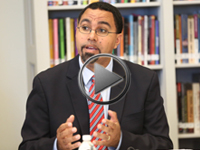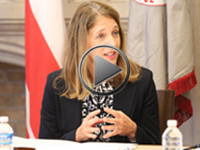 |
If asking parents this simple question could help ensure children stay healthier, do better in school, and even save a child’s life, should schools do it? More and more districts around the country are answering with a resounding yes! The Children’s Defense Fund (CDF) and AASA, The School Superintendents Association, have just released Happy, Healthy, and Ready to Learn: Insure All Children! a toolkit to help schools and districts connect children to health care coverage as part of routine school enrollment. After all, school is where more than 55 million children are expected daily this year to prepare for the future. The Obama Administration encourages these efforts, and on August 31st U.S. Secretary of Education John B. King Jr. and U.S. Secretary of Health and Human Services Sylvia Burwell joined District of Columbia Public Schools Chancellor Kaya Henderson, CDF, AASA, and other officials to discuss how all schools can get involved and help make sure all students are healthy and ready to learn.
“We know that efforts like the partnership between The School Superintendents Association and the Children’s Defense Fund can make a real difference connecting children to quality healthcare,” Secretary King said. “This is about in the end improving our outcomes because the future of our economy and our democracy depend on it.”
“It’s great to have a great partner like Secretary King in terms of the interaction between education and health and how we are dependent on education and education is helped by health,” said Secretary Burwell. “We are excited today about continuing that progress… because 3 out of 4 of those uninsured children walk through a school door…When we think about the children, this is where the children are reached and this is the place where there are trusted voices.”
Thanks in large part to Medicaid and the Children’s Health Insurance Program (CHIP), the number of uninsured children in the U.S. is at a historic low. But while our country has made great progress expanding health insurance for children, about 4.5 million children under 18 remain uninsured. These remaining uninsured children are often the hardest to reach because of various enrollment and retention barriers and are more likely to come from families with mixed immigration status, are homeless, or face other challenges. Schools are trusted entities in many of these children’s lives. That 2.8 million uninsured children are eligible for Medicaid or CHIP right now but not enrolled creates an opportunity for schools to help close the gap between the haves and have-nots.
Schools know better than anyone that healthy children thrive better in classrooms. How can a child who needs glasses to read or hearing aids to listen learn without them? She can’t. Unmet health needs are huge barriers to academic success. We have an abundance of evidence that insured children do better in school, are more likely to graduate from high school, and to be healthier and earn more as adults.
The Insure All Children toolkit offers lessons learned from 15 school districts in five states who have worked with CDF and AASA to create a simple, cost effective, and sustainable way to identify and enroll eligible but uninsured children in health insurance. This is something schools can do to help close achievement gaps right now and level the playing field for our poor and vulnerable children.
Lillian Maldonado French, the superintendent of a poor suburban California school district with whom we have collaborated says this is critical work, “It costs as much as you have. If you have enough to add a question to the form, then that’s what you do. If you have enough to perhaps hire someone to follow up, then that’s what you do. If you have enough to perhaps build a beautiful health clinic then that’s what you do. But you have to start.” Schools don’t have to do this alone. Community partners have joined hands with her district and she is now urging neighboring districts to do it too. She says, “You start with the first step and then you keep moving. And as you keep moving more opportunities come to you.”
When CDF began this work in Texas more than a decade ago, Texas had the highest rate of uninsured children in the country with more than a million children eligible for health coverage but not yet enrolled. Our goal was to create a simple, routine procedure so it could become part of what schools do. Working with school districts we developed the simple question to be asked on routine school enrollment forms – “Does your child have health insurance?” If families answered no, with parents’ permission CDF offered help with application and enrollment process.
Now this new online toolkit offers lessons learned so school districts everywhere in America can create their own successful health enrollment initiatives. CDF and AASA’s goal is to provide school and community leaders and parents and child advocates across the country a framework to build community support for connecting children to health insurance through schools and to provide the practical steps schools need to take to implement a successful and sustainable campaign.
We urgently need to change the odds to help our most vulnerable children succeed in our global economy. Giving every child a healthy start should be the goal of every school district, school and parent. As the Director of the District of Columbia’s Department of Health, Dr. LaQuandra S. Nesbitt says, “The insurance status is the great thing we want to begin with but we also have to get to the next step which is the great health outcomes and then the final step is beginning to have those education outcomes. Those are all the metrics for success that we need to have outlined at the very beginning of the effort so people understand that’s where we are trying to go.” When we insure our children’s health today, we are ensuring stronger communities and a stronger nation tomorrow.
Marian Wright Edelman is President of the Children’s Defense Fund whose Leave No Child Behind® mission is to ensure every child a Healthy Start, a Head Start, a Fair Start, a Safe Start and a Moral Start in life and successful passage to adulthood with the help of caring families and communities. For more information go to www.childrensdefense.org.
Mrs. Edelman’s Child Watch Column also appears each week on The Huffington Post.




